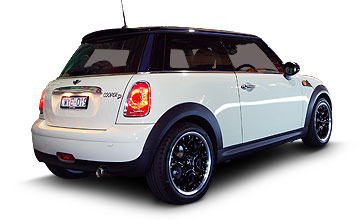BY DAVID HASSALL | 20th May 2009

Now we have another good reason to love the Mini – a great new turbo-diesel version that means it is the most fuel-efficient car in Australia, at least for now.
That claim might have to be relinquished or at least shared when the new-generation Toyota Prius hybrid arrives, but it’s an impressive claim to be able make in the meantime. The Prius will ultimately trump its emissions as well, but for now the 104g/km figure is again mighty impressive.
However, it is not just the Mini’s green credentials that make the Cooper D such a stand-out car, but the way it drives. In no way has it lost any of the sportiness of the regular Mini in fact, it is even more fun to drive, which is saying something.
Although the stats say that the 1.6-litre petrol Mini Cooper takes almost a second less to accelerate from rest to 100km/h, that is a little misleading because getting a figure like that with a petrol engine requires high revs and dumping the clutch, which tends to create a bit of attention at the traffic lights.
In the real world, the torquey 1.6-litre turbo-diesel Mini eases away quickly, with few revs and even short-shifting as you quickly reach the legal limit without fuss. It really is quite impressive and allows sporty driving without unsettling you or your passengers.
It’s not often that corporate hyperbole matches reality, but in the case of the Mini D it really is a case of not compromising excitement and performance in return for fuel economy and emissions. It’s smiles all-round.
This week’s 170km media launch drive included about 10 per cent city driving, 40 per cent highway cruising and 50 per cent enthusiastic driving on twisty mountain roads, yet we still averaged 4.7L/100km with a passenger aboard. That was much closer to the official 3.9L/100km combined average figure than we expected given the nature of our drive, so we were impressed by the results.
But even more impressive was the way the car performed on those mountain passes, accelerating willingly from low revs and continuing to haul smoothly through the gears. It felt more like a car you would choose to drive just for fun than one you had bought to save your wallet and the planet.
And it was quiet, too. From inside, you would not know there is a diesel engine under the bonnet, even when driven with gusto.
The only downside for enthusiastic drivers was a greater amount of tyre noise than expected, not just on the limit but even normal cornering, which we can only put down to low rolling-resistance tyres. With the radio on, though, you probably won’t even notice it.
Closer to the limit, tyre squeal also arrived much earlier than expected, and certainly before you felt the car breaking traction. Despite that, the level of grip was acceptably good and the Cooper D never felt unbalanced.
Similarly, all the usual Mini attributes of sharp steering, strong brakes and a general feeling of oneness prevailed, with the interior lending its usual aura of funky quality with its retro gauges and toggle switches.
Comfort was never a problem from either behind the wheel or from the passenger seat, but you wouldn’t want to spend much time in the little back seat. And you wouldn’t want to have to carry much gear in that tiny boot, either, or have a flat (there’s only a repair kit, not a spare wheel), but that’s the price you pay.
Speaking of price, the Mini has always come with a premium compared to other small cars, but at least you get something for the money in terms of apparent build quality, funky styling and sheer desirability. You just make your choices.
For the diesel, you pay an extra $2650 over the ‘atmo’ petrol version (for an RRP of $33,750) and we reckon it is worth every cent. Not only is it so good to drive with that grunty turbo-diesel performance, but you get a fair bit of tricky extra eco technology like the automatic idle-stop function, brake energy regeneration, automatic engine pumps and a gearshift change advisory display that you will probably never consider.
We did not like the idle-stop function because, unlike an electric or even hybrid (or perhaps a petrol-engined car), being a diesel engine, the Mini D shudders to a halt when you stop as if it has stalled and then shudders back to life when you take off again.
It is anything but smooth, or quiet. You may get used to it, but you’ll have to turn the function off when carrying passengers or you’ll need to explain it before you get the reputation for being incompetent by constantly stalling.
No doubt it does contribute to the low fuel use and emissions, but we’re not entirely convinced that it alone accounts entirely for the much worse consumption figures for the auto model, which does not yet come with the stop-start function.
However, seeing as the auto is a whopping 1.8L/100km higher than the manual around town and ‘only’ 0.7L/100km worse on the highway, it obviously accounts for quite a bit. We will be most interested to do some back-to-back comparisons with the function on and off around town when we do a full test.
As for the regenerative braking, energy is captured under braking and deceleration and fed back to the battery, reducing the work done by the alternator and therefore contributing to the overall efficiency.
Even on the strength of this first taste, we would have no hesitation recommending the Mini Cooper D to anyone looking for a fun, smile-inducing small car, let alone anyone with an environmental conscience or a desire to save money. For us, it is more like a Maxi D.